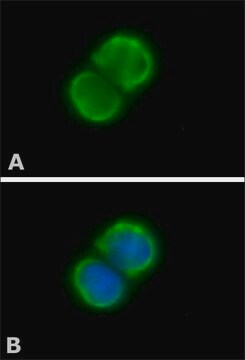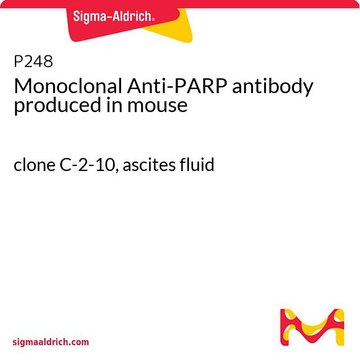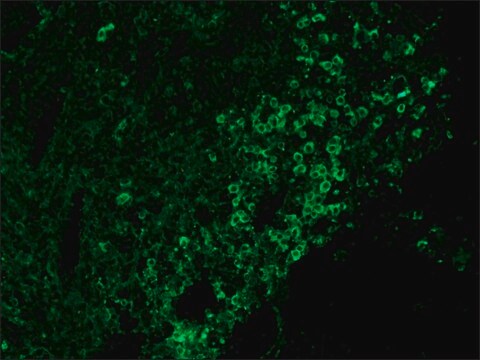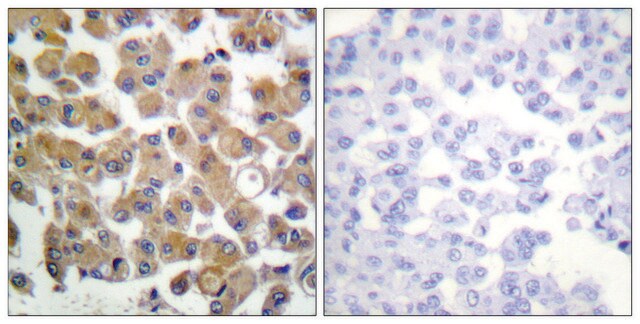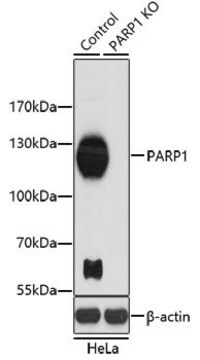MAB1476
Anti-Chymotrypsin Antibody, Human Pancreas
ascites fluid, Chemicon®
Sign Into View Organizational & Contract Pricing
All Photos(1)
About This Item
UNSPSC Code:
12352203
eCl@ss:
32160702
NACRES:
NA.41
Recommended Products
biological source
mouse
antibody form
ascites fluid
antibody product type
primary antibodies
clone
monoclonal
species reactivity
human
manufacturer/tradename
Chemicon®
technique(s)
ELISA: suitable
immunohistochemistry: suitable
isotype
IgG3
NCBI accession no.
UniProt accession no.
shipped in
dry ice
target post-translational modification
unmodified
General description
Chymotrypsin is an intestinal proteolytic enzyme composed of three polypeptide chains. It is produced in the pancrease as the inactive form chymotrypsinogen (single 245 aa chain). Chymotrypsinogen is activated in the duodenum by trypin and other active chymotrypsin molecules. It preferentially catalyzes the hydrolysis of peptide bonds involving L-isomers of tyrosine, phenylalanine and tryptophan. It also readily acts upon amides and esters of susceptible amino acids. Chymotrypsin catalyzes the hydrolysis of bonds of leucyl, methionyl, asparaginyl and glutamyl residues.
Specificity
Recognizes chymotrypsin.
Immunogen
Purified human pancreatic chymotrypsin.
Application
Detect Chymotrypsin using this Anti-Chymotrypsin Antibody, Human Pancreas validated for use in ELISA, IH.
ELISA
Immunohistochemistry: 1:1000.
Optimal working dilution must be determined by the end user.
Immunohistochemistry: 1:1000.
Optimal working dilution must be determined by the end user.
Research Category
Metabolism
Metabolism
Research Sub Category
Enzymes & Biochemistry
Enzymes & Biochemistry
Physical form
Liquid. Contains no preservative.
Storage and Stability
Maintain at -20°C in convenient aliquots for up to 12 months after date of receipt. Avoid repeated freeze/thaw cycles.
During shipment, small volumes of product will occasionally become entrapped in the seal of the product vial. For products with volumes of 200μL or less, we recommend gently tapping the vial on a hard surface or briefly centrifuging the vial in a tabletop centrifuge to dislodge any liquid in the container′s cap.
During shipment, small volumes of product will occasionally become entrapped in the seal of the product vial. For products with volumes of 200μL or less, we recommend gently tapping the vial on a hard surface or briefly centrifuging the vial in a tabletop centrifuge to dislodge any liquid in the container′s cap.
Legal Information
CHEMICON is a registered trademark of Merck KGaA, Darmstadt, Germany
Disclaimer
Unless otherwise stated in our catalog or other company documentation accompanying the product(s), our products are intended for research use only and are not to be used for any other purpose, which includes but is not limited to, unauthorized commercial uses, in vitro diagnostic uses, ex vivo or in vivo therapeutic uses or any type of consumption or application to humans or animals.
Not finding the right product?
Try our Product Selector Tool.
Storage Class Code
10 - Combustible liquids
WGK
WGK 1
Flash Point(F)
Not applicable
Flash Point(C)
Not applicable
Certificates of Analysis (COA)
Search for Certificates of Analysis (COA) by entering the products Lot/Batch Number. Lot and Batch Numbers can be found on a product’s label following the words ‘Lot’ or ‘Batch’.
Already Own This Product?
Find documentation for the products that you have recently purchased in the Document Library.
Fibronectin fragments promote human retinal endothelial cell adhesion and proliferation and ERK activation through alpha5beta1 integrin and PI 3-kinase
Wilson, Sylvia H, et al
Investigative Ophthalmology & Visual Science, 44, 1704-1715 (2003)
Pancreatic serous microcystic adenoma with extensive oncocytic change.
Takashi Akiyama,Yoshito Sadahira,Isao Irei,Hirotake Nishimura,Akira I Hida,Kenji Notohara et al.
Pathology International null
T Moritoyo et al.
Journal of neurovirology, 5(3), 241-248 (1999-07-22)
We investigated the role of viral transcripts of human T-lymphotropic virus type I (HTLV-I) in the cerebrospinal fluid (CSF) cells and peripheral blood mononuclear cells (PBMCs) of patients with human T-lymphotropic virus type I-associated myelopathy (HAM)/tropical spastic paraparesis (TSP). To
Syairah Hanan Shaharuddin et al.
Frontiers in cellular and infection microbiology, 11, 678482-678482 (2021-07-21)
COVID-19 pandemic has infected more than 154 million people worldwide and caused more than 3.2 million deaths. It is transmitted by the Severe Acute Respiratory Syndrome Coronavirus 2 (SARS-CoV-2) and affects the respiratory tract as well as extra-pulmonary systems, including
Markus Breunig et al.
Cell stem cell, 28(6), 1105-1124 (2021-04-30)
Personalized in vitro models for dysplasia and carcinogenesis in the pancreas have been constrained by insufficient differentiation of human pluripotent stem cells (hPSCs) into the exocrine pancreatic lineage. Here, we differentiate hPSCs into pancreatic duct-like organoids (PDLOs) with morphological, transcriptional, proteomic
Our team of scientists has experience in all areas of research including Life Science, Material Science, Chemical Synthesis, Chromatography, Analytical and many others.
Contact Technical Service
